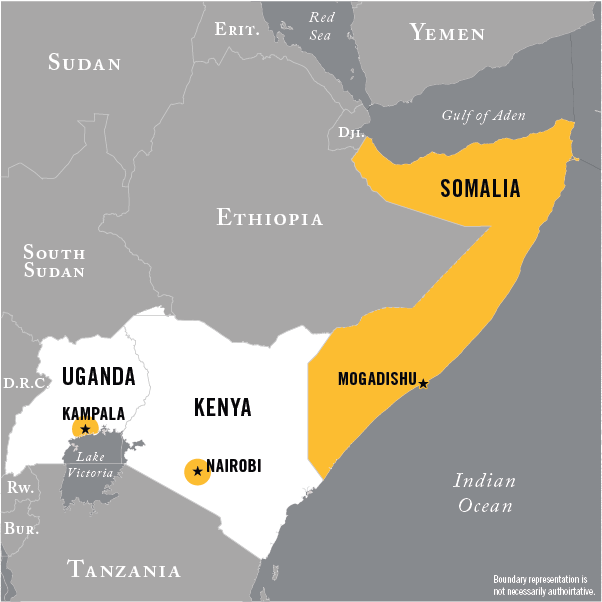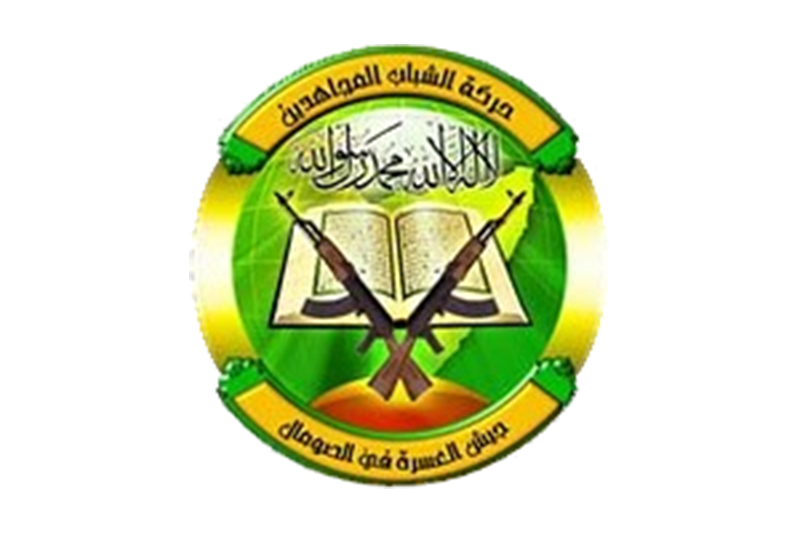TERRORIST GROUPS

BACKGROUND
The Harakat Shabaab al-Mujahidin—commonly known as al-Shabaab—was the militant wing of the Somali Council of Islamic Courts that took over most of southern Somalia in the second half of 2006. Despite the group’s defeat by Somali and Ethiopian forces in 2007, al-Shabaab—a clan-based insurgent and terrorist group—has continued its violent insurgency in southern and central Somalia. The group has exerted temporary and, at times, sustained control over strategic locations in those areas by recruiting, sometimes forcibly, regional sub-clans and their militias, using guerrilla warfare and terrorist tactics against the Federal Government of Somalia (FGS), African Union Mission in Somalia (AMISOM) peacekeepers, and nongovernmental aid organizations. Since 2011, however, pressure from AMISOM and Ethiopian forces has largely degraded al-Shabaab’s control, especially in Mogadishu but also in other key regions of the country, and conflict among senior leaders has exacerbated fractures within the group. In 2013 al-Shabaab rivalries culminated in a major purge of opponents of now-deceased group leader Ahmed Abdi Aw-Mohamed.

As evidenced by the constant levels of infighting among leadership, al-Shabaab is not centralized or monolithic in its agenda or goals. Its rank-and-file members come from disparate clans, and the group is susceptible to clan politics, internal divisions, and shifting alliances. Most of its fighters are predominantly interested in the nationalistic battle against the FGS and not supportive of global jihad. Al-Shabaab’s senior leaders remain affiliated with al-Qa‘ida. The merger of the two groups was publicly announced in February 2012 by the amir of al-Shabaab and Ayman al-Zawahiri, leader of al-Qa‘ida. The group, however, has lost four senior figures—including Abdi—since September 2014, which may have hampered its communications with al-Qa‘ida leadership.
Al-Shabaab has claimed responsibility for many bombings—including various types of suicide attacks—in Mogadishu and in central and northern Somalia, typically targeting Somali government officials, AMISOM, and perceived allies of the FGS. Since 2013 al-Shabaab has launched high-profile operations in neighboring countries, most notably the September 2013 Westgate mall attack in Nairobi, the May 2014 attack against a restaurant in Djibouti popular with Westerners, and the April 2015 massacre of university students in Garissa, Kenya. The Westgate attack killed 67 Kenyan and non-Kenyan nationals, and a siege continued at the mall for several days. The Garissa attack killed some 150 mainly Christian students.
Al-Shabaab is responsible for the assassination of Somali peace activists, international aid workers, numerous civil society figures, and journalists, and for blocking the delivery of aid from some Western relief agencies during the 2011 famine that killed tens of thousands of Somalis. In 2008, the US Government designated al-Shabaab as a Foreign Terrorist Organization under Section 219 of the Immigration and Nationality Act (as amended) and as a Specially Designated Global Terrorist entity under Section 1(b) of Executive Order 13224 (as amended). In 2012, the Rewards for Justice program added several al-Shabaab leaders to its site, offering large rewards for information leading to their capture.



